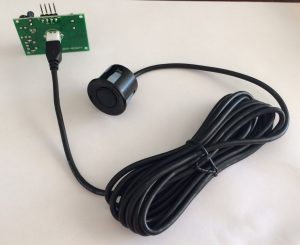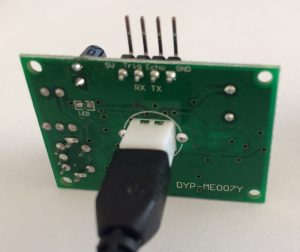In order to build a tank level monitoring device, we recently bought a pile of DYP-ME007Y ultrasonic devices. We chose the single sensor version with the automotive sensor used for car parking distance when mounted on the bumper.


Having tried to use both the manual ‘pulse-trigger then measure the response’ and NewPing code, we gave up.
It turns out that there are two (well, actually three) different versions of this module, and it is not that obvious which one is which.
The two versions are Pulse Width Modulation (PWM) and Serial.
The PWM one requires a trigger input to fire it and this flashes the LED once. You then read the pulse from the Echo output.
The Serial version constantly takes readings, and outputs a distance value in mm in serial. The constant readings result in a flashing LED as soon as you apply power.
So – simple test when you apply power only:
No flashes – PWM version
Flashes – Serial version
The PWM version is well-documented, and easy to interface with on Arduino using the NewPing library but the Serial version is not. There is no way of telling from the markings on the board as these show the pin assignments for both versions.
For specification, look for the DYP-ME007TX which shows:
- Supply voltage 5 v
- Global Current Consumption 15 mA
- Ultrasonic Frequency 40k Hz
- Maximal Range 400 cm
- Minimal Range 3 cm
- Resolution 1 cm
- Baud rate 9600 n,8,1
- Outline Dimension 43x20x15 mm
However, our testing shows with the automotive sensor the minimum distance is 30cm.
Also useful is the spec of the output which is four 8-bit bytes:
- 0xFF: frame start marker byte.
- H_DATA: distance data of high eight.
- L_DATA: distance data of low 8 bits.
- Checksum byte: Value should equal 0xFF + H_DATA + L_DATA (only lowest 8 bits)